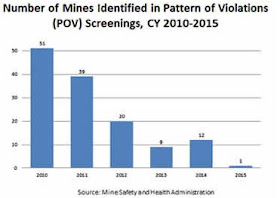Recent Pattern of Violations reforms by MSHA led to
significant improvements in mine safety, culture change
High violation rates drop, fewest mines identified in screening for chronic violators
ARLINGTON, VAThe Pattern of Violations reforms put in place by the U.S. Department of Labor's Mine Safety and Health Administration have been "real game changers" in protecting miners and promoting a culture focused on safety and health in mines across the nation, Joseph A. Main, assistant secretary of labor for mine safety and health, said today.
Under the Federal Mine Safety and Health Act of 1977, MSHA can issue a POV notice to mine operators that show a disregard for workers' safety and health through a pattern of "Significant and Substantial" violations. One of the agency's toughest enforcement actions, a POV notice is reserved for mines that pose the greatest risk to miners' safety and health.
The agency conducts at least one POV review each year. MSHA recently conducted its third POV screening, under a rule revised in January 2013, which added to reforms the agency made in 2010. During the screening, MSHA found only one of the nation's approximately 13,600 mines — a coal operation — warranted further review, the fewest number of both coal and metal and nonmetal mines identified for additional scrutiny since the 2010 reforms. Upon completion of the review, no coal or metal and nonmetal mines met the criteria for further consideration of a POV notice.
MSHA has issued seven POV notices since the 2010 reforms. While enacted in 1977, no mine had been effectively placed on a POV until 2011, after assistant secretary Main directed the implementation of sweeping reforms to MSHA's POV procedures in the aftermath of the April 2010 Upper Big Branch coal mine explosion. The agency identified shortcomings and the need for reforms in the procedures.
"The POV reforms sent a message that chronic violator behavior would no longer be tolerated. That message translated into a dramatic reduction in the number of mines with chronic violation records," said Main. "We have also seen significant improvements in violation and injury rates at mines served with a POV notice."
Since 2010, mines subject to a POV notice — or potential POV notice under the prior rule — showed improved compliance. The number of S&S violations issued at those mines declined 64 percent, the number of unwarrantable failure violations decreased 82 percent, total violations fell 39 percent, and the operator-reported rate of lost-time injuries decreased 50 percent.
Data also indicate that MSHA's actions have helped drive better compliance well beyond just the mines that met the criteria for further consideration for a POV notice. Between the 2010 and 2015 screenings, there was a 40 percent drop in S&S violations among the top 200 mines ranked by number of S&S issuances.
Those mines also saw a 27 percent reduction in total violations and a 16 percent decrease in elevated enforcement actions, such as closure orders for imminent dangers or unwarrantable failures to comply with health and safety standards.
MSHA has developed online tools to help mine operators monitor compliance. They include:
- A POV monitoring tool that allows mine operators to monitor each mine's performance each month under the POV screening criteria. Introduced by MSHA in April 2011, the tool puts operators on notice so that they can take corrective actions to improve Mine Act compliance.
- The S&S rate calculator that enables mine operators to monitor their S&S violations and proactively implement a corrective action program to prevent S&S violations at their mines. The calculator complements the POV monitoring web tool. MSHA launched the calculator in August 2013.
"The POV reforms we have put in place provide mine operators with guidance on how to improve compliance if they start down the wrong path, and most importantly, to better protect our nation's miners from injury, illness and death," said Main. "In fact, a number of mines proactively implemented corrective action programs, which is what both Congress and our rule encouraged," he added.
//--------------------///
Pattern of Violations
The Mine Act places the responsibility for ensuring the health and safety of miners on mine operators. Congress enacted the pattern of violations (POV) provision
to provide MSHA with an additional enforcement tool when other tools
had proven ineffective. Congress intended MSHA to use the POV provision
to restore safe and healthful conditions at mines with a pattern of
significant and substantial (S&S) violations. The legislative
history states that Congress believed the existence of a pattern would
signal to both the mine operator and the Secretary that ‘‘there is a
need to restore the mine to effective safe and healthful conditions and
that the mere abatement of violations as they are cited is
insufficient.”A mine operator that has a pattern of S&S violations at a mine will receive written notice from MSHA. For each subsequent S&S violation, MSHA will issue an order withdrawing miners from the affected area until the cited condition has been corrected. MSHA will terminate an operator’s POV notice when 1) an inspection of the entire mine is completed and no S&S violations are found or 2) no withdrawal order is issued by MSHA in accordance with Section 104(e)(1) of the Mine Act within 90 days of the issuance of the pattern notice.
Mine operators can determine whether they may be subject to a POV notice by using MSHA’s Pattern of Violations Monitoring Tool. It is the responsibility of mine operators to track their violation and injury histories to determine whether they need to take action to avoid triggering a POV notice. Operators who are at risk of receiving a POV notice are encouraged to implement a corrective action program to reduce S&S violations. More information about corrective action programs can be found in MSHA’s Pattern of Violations Procedures Summary.
